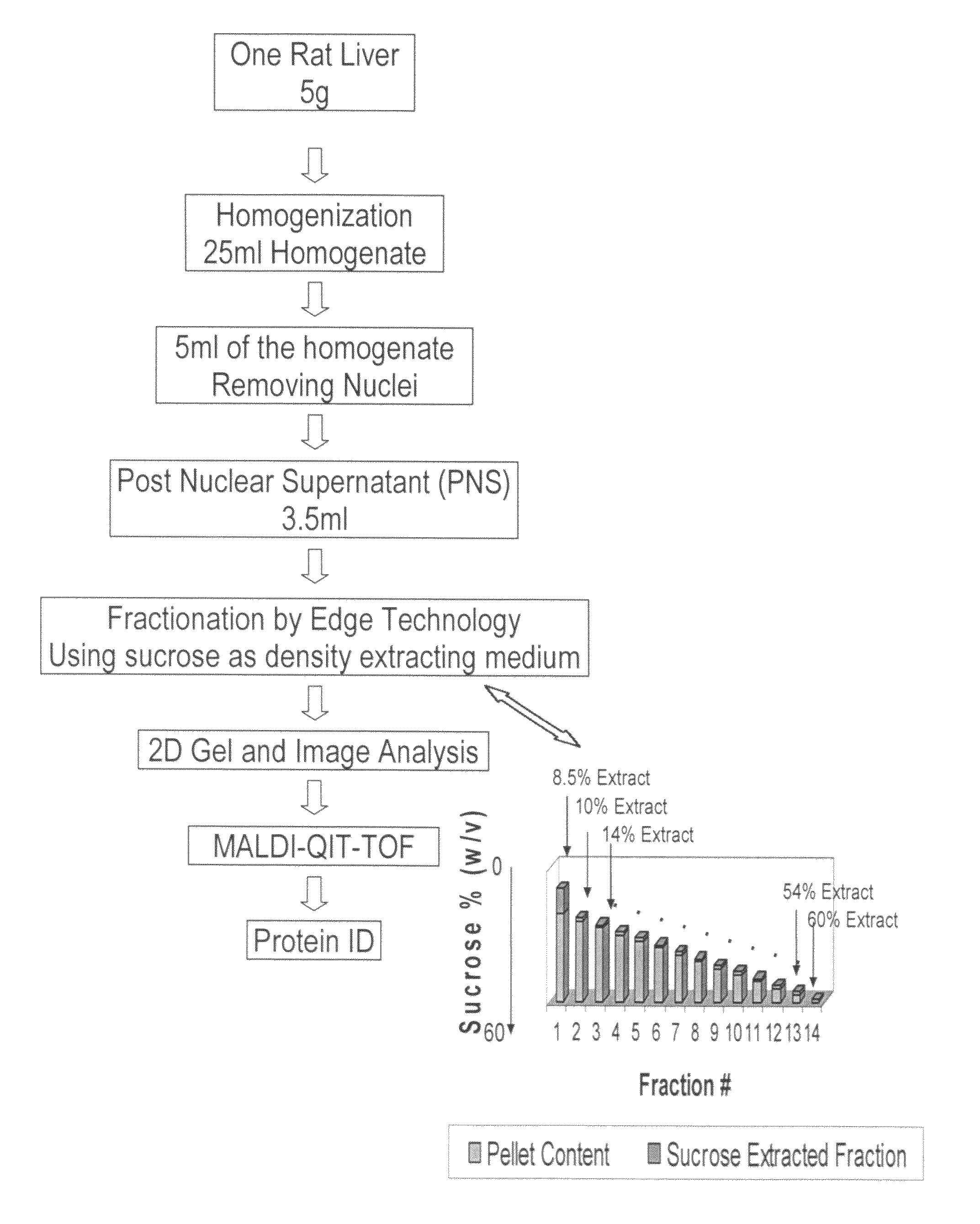Method for the fractionation and separation of particles by step-wise gradient density extraction
a gradient density and particle technology, applied in the field of particle fractionation, can solve the problems of high cost, complex and time-consuming, and classical fractionation methods that have not kept pace with the increased sensitivity of protein analysis, and achieve the effect of efficient process for particle separation
- Summary
- Abstract
- Description
- Claims
- Application Information
AI Technical Summary
Benefits of technology
Problems solved by technology
Method used
Image
Examples
example 1
Subcellular Particle Fractionation and Proteomics Study of Rat Liver
[0105]The work flow of the rat liver subcellular fractionation and proteomics analysis is shown in FIG. 4.
[0106]I. Post Nuclear Supernatant Preparation: A rat liver post nuclear supernatant (PNS) from rat liver was prepared from a Sprague-Dawley rat (7-8 weeks of age). One frozen rat liver (about 5 g, Pel-Freez, Fayetteville, Ariz.) was thawed in 10 ml homogenization buffer (250 mM sucrose, 10 mM HEPES, 10 mM KCl, 1 mM EDTA, 10 μl protease inhibitor cocktail solution, pH 7.4) at 4° C. until the liver tissue turned soft. The thawed rat liver was diced into about 3 mm pieces with a pair of sharp scissors in the homogenization buffer. To the diced liver and homogenization buffer suspension was added an additional 10 ml of homogenization buffer. Half of the diced liver suspension was transferred to a prechilled 15 ml glass Dounce homogenizer. The rat liver was homogenized for 18-20 stokes using a loose pestle. The liver...
example 2
Virus Particle Separation from BmMLV
[0113]I: BmMLV virus preparation: Silkworm larvae (Kinshu.times.Showa strain) are injected at day 1 in the fifth instar with 150 μl of virus solution (equivalent to 1.0×108 BmN cells) in phosphate-buffered saline (PBS). The virus solution is prepared as follows: 1.6×108 BmN cells are homogenized in 75 ml of PBS and centrifuged at 7,000×g for 15 min at 4° C. After centrifugation, the supernatants are filtered (0.22-μm-pore-size filter) and used as the virus solution. BmN cells are harvested silkworm larvae, washed with PBS, and sonicated in 20 volumes of PBS. After low-speed centrifugation, the supernatants are filtered (0.22-μm-pore-size filter) and concentrated with an Amicon Ultra filter (Millipore).
[0114]II: BmMLV virus particle separation: The concentrated virus solution is subjected to the instant particle fractionation method using cesium chloride (CSCl) in buffer solution (10 mM Tris, 2 mM EDTA, pH 7.4) as an extracting density medium. The ...
example 3
Fractionation of Tissue Homogenates from Control and HF Diet Rats and Evaluation Potential Biomarkers: p-Synapsin I and GRP 75
[0127]I. Fractionation of Rat Brain and Heart tissue: The entire homogenization process was performed on ice. One frozen brain or heart was thawed in ice cold 1× homogenization buffer (20 mM HEPES, 1 mM Na2EDTA and 320 mM sucrose, pH 7.4 for brain; 20 mM HEPES, 10 mM KCl, 1 mM Na2EDTA and 250 mM sucrose, pH 7.4 for heart) with 0.01% v / v protease inhibitor cocktail. The tissue was dissected into 2-3 mm3 pieces and the liquid was carefully discarded. The brain tissue pieces were resuspended in 5 volumes of brain homogenization buffer and the suspension was transferred to a glass homogenizer. The tissue was homogenized up-down 10 times by a loose pestle, and then followed by another 10 up-down times with a tight pestle. The crude homogenate was transferred to several centrifuge tubes and centrifuged at 800 g force for 10 minutes to remove nuclei. The supernatant...
PUM
| Property | Measurement | Unit |
|---|---|---|
| density | aaaaa | aaaaa |
| volume | aaaaa | aaaaa |
| volume | aaaaa | aaaaa |
Abstract
Description
Claims
Application Information
 Login to View More
Login to View More - R&D
- Intellectual Property
- Life Sciences
- Materials
- Tech Scout
- Unparalleled Data Quality
- Higher Quality Content
- 60% Fewer Hallucinations
Browse by: Latest US Patents, China's latest patents, Technical Efficacy Thesaurus, Application Domain, Technology Topic, Popular Technical Reports.
© 2025 PatSnap. All rights reserved.Legal|Privacy policy|Modern Slavery Act Transparency Statement|Sitemap|About US| Contact US: help@patsnap.com



